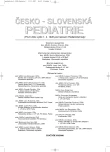Transcutaneous Bilirubinometry in Preterm Newborns
Authors:
L. Štillová 1; K. Maťašová 1; T. Mikitová 1; J. Štilla 2; H. Kolarovszká 1; M. Zibolen 1
Authors‘ workplace:
Neonatologická klinika JLF UK a MFN, Martin
prednosta prof. MUDr. M. Zibolen, CSc.
1; Klinika stomatológie a maxilofaciálnej chirurgie JLF UK a MFN, Martin
prednostka doc. MUDr. D. Statelová, PhD.
2
Published in:
Čes-slov Pediat 2008; 63 (1): 3-8.
Category:
Original Papers
Overview
Objective:
To evaluate reliability of transcutaneous measurement of bilirubin concentration using Air-Shields Minolta JM-103 device in preterm newborns, and to compare the results obtained over forehead, sternum and abdomen.
Patients and methods:
The study group consisted of 68 newborns born within 32.–37. gestational weeks, who had not been treated for hyperbilirubinemia. Differences (their mean values and CI 95%) between the transcutaneous value of bilirubin concentration over forehead (ΔC), sternum (ΔS) and abdomen (ΔB) and the value of serum bilirubin concentration were prospectively evaluated. Correlation coefficients were calculated.
Results:
Serum bilirubin concentration ranged from 38.3 to 292.4 μmol/l. The correlation between bilirubin concentration values obtained by means of laboratory and transcutaneous measurements was close (r >0.70). Transcutaneous measurements over sternum (ΔS = 0.9 μmol/l; CI 95% = 9.3 μmol/l) and abdomen (ΔB = 1.1 μmol/l; CI 95% = 9.4 μmol/l) did not show significant differences. Transcutaneous measurements over forehead underestimated serum bilirubin concentrations significantly (ΔC = –21.9 μmol/l; CI 95% = 6.8 μmol/l).
Conclusion:
Transcutaneous measurements using Minolta JM-103 in preterm newborns are considered to be reliable due to the close correlation. Based on the results the authors recommend noninvasive measurements of bilirubin concentration over sternum and abdomen in preterm newborns of more than 31 weeks of gestation. Transcutaneous bilirubinometry seems to be an appropriate and reliable method to identify newborns with significant hyperbilirubinemia.
Key words:
preterm newborn, bilirubin, hyperbilirubinemia, jaundice, transcutaneous measurement, Minolta JM-103
Sources
1. Bauer F, Madiová A. Novorodenecké žltačky. In: Zibolen M, et al. Praktická neonatológia. 1. vyd. Martin: Neografia, 2001: 178–188.
2. Kiely M, Drum MA, Kessel K. Early discharge. Clin. Perinatol. 1998;25: 539–553.
3. Kumral A, Genc S, Genc K, et al. Hyperbilirubinemic serum is cytotoxic and induces apoptosis in murine astrocytes. Biology of the Neonate 2005;87: 99–104.
4. Ip S, Chung M, Kulig J, et al. Subcommittee in hyperbilirubinemia. An evidence-based review of important issues concerning neonatal hyperbilirubinemia. Pediatrics 2004;114(1): 130–153.
5. Bertini G, Dani C, Pezzati M, Rubaltelli FF. Prevention of bilirubin encephalopathy. Biology of the Neonate 2001;79: 219–223.
6. Ebbesen F. Recurrence of kernicterus in term and near-term infants in Denmark. Acta Pediatr. 2000;89: 1213–1217.
7. Hansen TW. Mechanisms of bilirubin toxicity: clinical implications. Clin. Perinatol. 2002;29: 765–778.
8. Mansi G, De Maio C, Araimo G, et al. „Safe“ hyperbilirubinemia is associated with altered neonatal behavior. Biology of the Neonate 2003;83: 19–21.
9. Dragula M, Bakoš J, Horáková M, Murgaš D, Szépeová R, Hladká M, Dibdiak D. Ochorenia žlčových ciest detí. In: Diagnostika a terapia v pediatrii. Martin: JLF UK, 2000: 31–36.
10. Yasuda S, Itoh S, Isobe K, et al. New transcutaneous jaundice device with two optical paths. J. Perinat. Med. 2003;31: 81–88.
11. Maisels MJ, Ostrea EM, Touch S, et al. Evaluation of a new transcutaneous bilirubinometer. Pediatrics 2004;113: 1628–1635.
12. Sanpavat S, Nuchprayoon I. Noninvasive transcutaneous bilirubin as a screening test to identify the need for serum bilirubin assessment. J. Med. Assoc. Thai. 2004;87: 1193–1198.
13. Sanpavat S, Nuchprayoon I. Comparison of two transcutaneous bilirubinometers – Minolta AirShields Jaundice Meter JM103 and Spectrx Bilicheck – in Thai neonates. Southeast Asian J. Trop. Med. Public Health 2005;36: 1533–1537.
14. Ho HT, Ng TK, Tsui KC, Lo YC. Evaluation of a new transcutaneous bilirubinometer in Chinese newborns. Archives of Disease in Childhood – Fetal and Neonatal Edition 2006;91: F434–F438.
15. Maťašová K, Zibolen M, Čiljak M, Kolarovszká H, Murgaš D, Baška T. Spoľahlivosť neinvazívneho merania koncentrácie bilirubínu u zdravých novorodencov. Čes.-slov. Pediat. 2005;60: 599–605.
16. Knupfer M, Pulzer F, Braun L, et al. Transcutaneous bilirubinometry in preterm infants. Acta Paediatr. 2001;90: 899–903.
17. Willems WA, van den Berg LM, de Wit H, Molendijk A. Transcutaneous bilirubinometry with the Bilicheck in very premature newborns. Journal of Maternal-Fetal and Neonatal Medicine 2004;16: 209–214.
18. Karolyi L, Pohlandt F, Muche R, et al. Transcutaneous bilirubinometry in very low birthweight infants. Acta Paediatrica 2004;93: 941–944.
19. Jangaard KA, Curtis H, Goldbloom RB. Estimation of bilirubin using BiliChek, a transcutaneous bilirubin measurement device: Effects of gestational age and use of phototherapy. Paediatr Child Health 2006;11: 79–83.
20. Subcommittee in Hyperbilirubinemia. Management of hyperbilirubinemia in the newborn infant 35 or more weeks of gestation. Pediatrics 2004;114(1): 297–316.
21. Rennie JM, Roberton NRC. Neonatal jaundice and liver disease. In: Rennie JM, Roberton NRC. A Manual of Neonatal Intensive Care. 4th ed. London: Arnold 2002: 417–418.
22. Maisels MJ. Historical perspectives: Transcutaneous bilirubinometry. NeoReviews 2006;7(5): e217.
23. Ahn YM, Kim MR, Lee SM, Jun YH. Assessment of neonatal hyperbilirubinemia using a transcutaneous bilirubinometry. J. Korean Acad. Nurs. 2003;33(1): 51–59.
24. Leung NK, Auyeung CL, Chan KY. Transcutaneous bilirubinometry: a non-invasive method of evaluating jaundice in Chinese term infants. J. Pediatr. 1985;2: 32–36.
25. Szabo P, Wolf M, Bucher HU, et al. Assessment of jaundice in preterm neonates: comparison between clinical assessment, two transcutaneous bilirubinometers and serum bilirubin values. Acta Pediatr. 2004;93: 1491–1495.
26. Knudsen A, Ebbesen F. Transcutaneous bilirubinometry in neonatal intensive care units. Archives of Disease in Childhood – Fetal and Neonatal Edition 1996;75: F53–F56.
Labels
Neonatology Paediatrics General practitioner for children and adolescentsArticle was published in
Czech-Slovak Pediatrics

2008 Issue 1
- What Effect Can Be Expected from Limosilactobacillus reuteri in Mucositis and Peri-Implantitis?
- The Importance of Limosilactobacillus reuteri in Administration to Diabetics with Gingivitis
Most read in this issue
- Aspirated Foreign Bodies in Children
- Early Diagnostics of Asperger Syndrome and Specific Aspects
- Neural Tube Defects – Current Opinion on Etiopathogenesis and Prevention Potencial of Folic Acid
- Transcutaneous Bilirubinometry in Preterm Newborns
